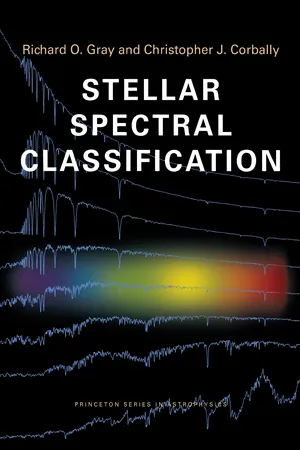
- 592 pages
- English
- PDF
- Available on iOS & Android
Stellar Spectral Classification
About this book
Written by leading experts in the field, Stellar Spectral Classification is the only book to comprehensively discuss both the foundations and most up-to-date techniques of MK and other spectral classification systems. Definitive and encyclopedic, the book introduces the astrophysics of spectroscopy, reviews the entire field of stellar astronomy, and shows how the well-tested methods of spectral classification are a powerful discovery tool for graduate students and researchers working in astronomy and astrophysics.
The book begins with a historical survey, followed by chapters discussing the entire range of stellar phenomena, from brown dwarfs to supernovae. The authors account for advances in the field, including the addition of the L and T dwarf classes; the revision of the carbon star, Wolf-Rayet, and white dwarf classification schemes; and the application of neural nets to spectral classification. Copious figures illustrate the morphology of stellar spectra, and the book incorporates recent discoveries from earth-based and satellite data. Many examples of spectra are given in the red, ultraviolet, and infrared regions, as well as in the traditional blue-violet optical region, all of which are useful for researchers identifying stellar and galactic spectra. This essential reference includes a glossary, handy appendixes and tables, an index, and a Web-based resource of spectra.
In addition to the authors, the contributors are Adam J. Burgasser, Margaret M. Hanson, J. Davy Kirkpatrick, and Nolan R. Walborn.
Frequently asked questions
- Essential is ideal for learners and professionals who enjoy exploring a wide range of subjects. Access the Essential Library with 800,000+ trusted titles and best-sellers across business, personal growth, and the humanities. Includes unlimited reading time and Standard Read Aloud voice.
- Complete: Perfect for advanced learners and researchers needing full, unrestricted access. Unlock 1.4M+ books across hundreds of subjects, including academic and specialized titles. The Complete Plan also includes advanced features like Premium Read Aloud and Research Assistant.
Please note we cannot support devices running on iOS 13 and Android 7 or earlier. Learn more about using the app.
Information
Table of contents
- Cover Page
- Title Page
- Copyright Page
- Dedication
- Contents
- Preface
- Important Note on Terminology and Units
- Chapter 1. The History and Philosophy of Stellar Spectral Classification
- Chapter 2. An Overview of the Normal Stars
- Chapter 3. The OB Stars—Nolan R. Walborn
- Chapter 4. The B-type Stars
- Chapter 5. The A-type Stars
- Chapter 6. The F-type Stars
- Chapter 7. The G- and K-type Stars
- Chapter 8. The M-type, S-type, and Carbon Stars
- Chapter 9. M Dwarfs and L Dwarfs—J. Davy Kirkpatrick
- Chapter 10. The T-type Dwarfs—Adam J. Burgasser
- Chapter 11. Wolf–Rayet Stars and the Luminous Blue Variables
- Chapter 12. Endpoints of Stellar Evolution
- Chapter 13. Further Techniques
- Glossary
- Appendix A: MK Standard Stars
- Appendix B: Calibrations of the MK System
- Appendix C: The Book Website
- General Index
- Object Index